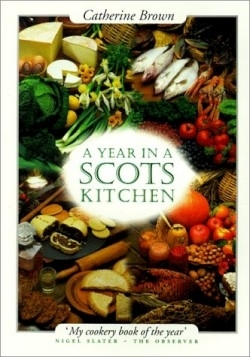
A Year in a Scots Kitchen
Choosing a useful cookbook does not come easily or naturally to many homecooks. Often they stumble through the myriad choices to be lured and finally captured by looks. It is only after delving into a cookbook and preparing several of its recipes that many cooks can begin to truly know if they have purchased a cookbook with substance, one that can teach them, change them and make them better cooks.
In her cookbook A Year in a Scots Kitchen Brown presents the reader with a cookbook of substance. This modest but powerful book goes beyond the mere preparation of something to fill the stomach. Brown’s motives are twofold: help readers infuse meaning back into what they eat and advise them on choosing their food. She feels that Scotland is a place that can serve as a wise model. Brown also wants readers to fall in love with the country, its history, people and their traditions as well as its natural resources.
At first look Brown’s book can be somewhat off-putting. There are no fancy pictures. The recipes do not dominate—the reader must search them out. The recipes share space with large doses of history and anecdote. Occasionally the reader needs an interpreter. Many of the words and names of dishes are mystifying. But Brown thoughtfully accompanies readers throughout, deftly defining the mysterious and the exotic.
The inventive names give readers a peek into the wit and charm of the Scots. A wordsmith’s delight, they are almost a reason to read the cookbook by themselves. Brown introduces us to rumbledethumps (potatoes, cabbage and butter), clapshot (boiled vegetable dinner with potatoes, kale, and turnips or rutabagas) and gusty kickshaws (hot savories).
Brown organizes her book around the Celtic year, which begins on October 31. In Part One she covers the dishes of Winter and Spring. Often Brown first describes an ancient rite or dish, then goes on to give a recipe for the twentieth century derivative dish. Present day Scottish Halloween cake with charms arose from stapag, cream stirred and thickened with oatmeal into which the cook dropped charms. The household gathered round the communal bowl of stapag and scraped and scooped to see what fortune would end up in their spoons.
Winter solstice (which begins on Christmas Eve) heralded winter festivities and merrymaking which many Scots still celebrate such as Daft Days, Hogmanay and Up-Helly-Aa (the Viking Yule). Brown describes the festivities and history of each in detail. She gives recipes for traditional celebratory dishes such as clootie dumpling, shortbread, steak pie, marmalade and haggis.
Haggis (sheep stomach stuffed with oatmeal and innards and boiled) is the dish many Americans hang like a scarlet letter around Scotland’s neck. Brown tackles this connotation of Scottish bad taste head-on with honesty. Brown credits revered Scottish poet William Burns for immortalizing this “ugly old pudding” in his Address to Haggis. He made it into a symbol of the need to judge not only by appearance but by innate sense and worth. Calling haggis “something which has little, if any, visual appeal,” Brown glides through with two recipes for it—a traditional and a sweet haggis.
Part Two covers Summer and Autumn, the time for Beltane, the Celtic spring and the bounty of the Scottish earth and sea. Here Brown’s enthusiasm and love for Scotland rev into high gear. Her descriptions of Scotland’s summer riches glow: glistening raspberries, blueberries and mushrooms; seaweeds, salmon and haddock still smelling of the pungent, salty sea; colorful, fragrant herb and flowers for salad.
Brown’s pieces on venison, game birds, Scottish cheeses (nine pages), Scottish beef and seafood are wonderfully informative and appealing. Her recipes are simple and superb. Brown does not just include recipes for seafood, oats, barley, beef, cheese, honey or berries, she tells about each variety, its most desirable qualities, texture and flavor; how and where food originates and grows best.
Brown is an exhaustive researcher, tour guide and vivid writer. This book invites the reader to slow down, sit and make friends. If even for only twenty minutes, this book begs to be savored at the beach or before bed. The recipes are secondary. If the reader truly loves food and culture, he or she will be mentored and educated by A Year in a Scots Kitchen.
Scotland is the wild heart of Britain. This book reflects the delightful character, knowledge, strength and vitality of these people and their food. A Year in a Scots Kitchen can, if given the time, shepherd readers into a more robust connection with what they eat and a lively awareness of the rhythms of life around them.
Reviewed by
Nancy K. Allen
Disclosure: This article is not an endorsement, but a review. The publisher of this book provided free copies of the book to have their book reviewed by a professional reviewer. No fee was paid by the publisher for this review. Foreword Reviews only recommends books that we love. Foreword Magazine, Inc. is disclosing this in accordance with the Federal Trade Commission’s 16 CFR, Part 255.
